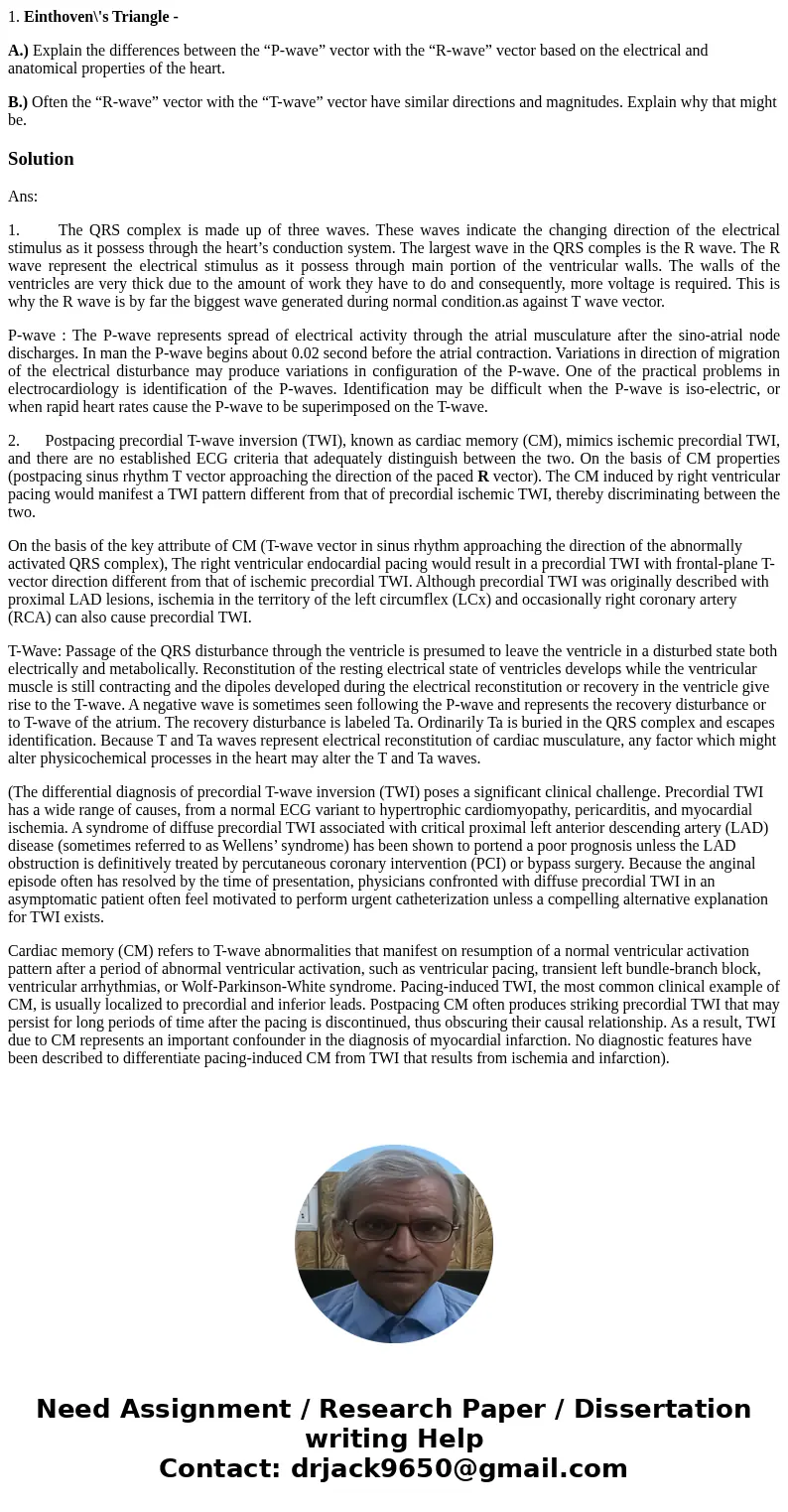1 Einthovens Triangle A Explain the differences between the
1. Einthoven\'s Triangle -
A.) Explain the differences between the “P-wave” vector with the “R-wave” vector based on the electrical and anatomical properties of the heart.
B.) Often the “R-wave” vector with the “T-wave” vector have similar directions and magnitudes. Explain why that might be.
Solution
Ans:
1. The QRS complex is made up of three waves. These waves indicate the changing direction of the electrical stimulus as it possess through the heart’s conduction system. The largest wave in the QRS comples is the R wave. The R wave represent the electrical stimulus as it possess through main portion of the ventricular walls. The walls of the ventricles are very thick due to the amount of work they have to do and consequently, more voltage is required. This is why the R wave is by far the biggest wave generated during normal condition.as against T wave vector.
P-wave : The P-wave represents spread of electrical activity through the atrial musculature after the sino-atrial node discharges. In man the P-wave begins about 0.02 second before the atrial contraction. Variations in direction of migration of the electrical disturbance may produce variations in configuration of the P-wave. One of the practical problems in electrocardiology is identification of the P-waves. Identification may be difficult when the P-wave is iso-electric, or when rapid heart rates cause the P-wave to be superimposed on the T-wave.
2. Postpacing precordial T-wave inversion (TWI), known as cardiac memory (CM), mimics ischemic precordial TWI, and there are no established ECG criteria that adequately distinguish between the two. On the basis of CM properties (postpacing sinus rhythm T vector approaching the direction of the paced R vector). The CM induced by right ventricular pacing would manifest a TWI pattern different from that of precordial ischemic TWI, thereby discriminating between the two.
On the basis of the key attribute of CM (T-wave vector in sinus rhythm approaching the direction of the abnormally activated QRS complex), The right ventricular endocardial pacing would result in a precordial TWI with frontal-plane T-vector direction different from that of ischemic precordial TWI. Although precordial TWI was originally described with proximal LAD lesions, ischemia in the territory of the left circumflex (LCx) and occasionally right coronary artery (RCA) can also cause precordial TWI.
T-Wave: Passage of the QRS disturbance through the ventricle is presumed to leave the ventricle in a disturbed state both electrically and metabolically. Reconstitution of the resting electrical state of ventricles develops while the ventricular muscle is still contracting and the dipoles developed during the electrical reconstitution or recovery in the ventricle give rise to the T-wave. A negative wave is sometimes seen following the P-wave and represents the recovery disturbance or to T-wave of the atrium. The recovery disturbance is labeled Ta. Ordinarily Ta is buried in the QRS complex and escapes identification. Because T and Ta waves represent electrical reconstitution of cardiac musculature, any factor which might alter physicochemical processes in the heart may alter the T and Ta waves.
(The differential diagnosis of precordial T-wave inversion (TWI) poses a significant clinical challenge. Precordial TWI has a wide range of causes, from a normal ECG variant to hypertrophic cardiomyopathy, pericarditis, and myocardial ischemia. A syndrome of diffuse precordial TWI associated with critical proximal left anterior descending artery (LAD) disease (sometimes referred to as Wellens’ syndrome) has been shown to portend a poor prognosis unless the LAD obstruction is definitively treated by percutaneous coronary intervention (PCI) or bypass surgery. Because the anginal episode often has resolved by the time of presentation, physicians confronted with diffuse precordial TWI in an asymptomatic patient often feel motivated to perform urgent catheterization unless a compelling alternative explanation for TWI exists.
Cardiac memory (CM) refers to T-wave abnormalities that manifest on resumption of a normal ventricular activation pattern after a period of abnormal ventricular activation, such as ventricular pacing, transient left bundle-branch block, ventricular arrhythmias, or Wolf-Parkinson-White syndrome. Pacing-induced TWI, the most common clinical example of CM, is usually localized to precordial and inferior leads. Postpacing CM often produces striking precordial TWI that may persist for long periods of time after the pacing is discontinued, thus obscuring their causal relationship. As a result, TWI due to CM represents an important confounder in the diagnosis of myocardial infarction. No diagnostic features have been described to differentiate pacing-induced CM from TWI that results from ischemia and infarction).

 Homework Sourse
Homework Sourse